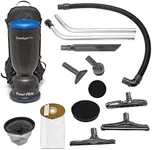Buying Guide for the Best Backpack Vacuums
Choosing the right backpack vacuum can make cleaning much easier, especially if you need to cover large areas or work in spaces where maneuverability is important. The key is to find a model that balances comfort, power, and features that match your cleaning needs. Before you buy, think about where and how often you'll use the vacuum, the types of surfaces you'll clean, and how much weight you're comfortable carrying. Understanding the main specifications will help you make a smart choice.WeightWeight refers to how heavy the backpack vacuum is when it's empty. This is important because you'll be carrying it on your back for extended periods, and a heavier vacuum can cause fatigue or discomfort. Backpack vacuums typically range from lightweight (around 8-10 pounds) to heavier models (over 15 pounds). If you plan to use the vacuum for long cleaning sessions or have to move up and down stairs, a lighter model is usually better. However, heavier models may offer more power or larger capacity, so consider your strength and how long you'll be wearing it.
CapacityCapacity means how much dust and debris the vacuum can hold before it needs to be emptied. This is measured in quarts or liters. Smaller capacities (around 2-4 quarts) are lighter and easier to carry, but you'll need to empty them more often. Larger capacities (6 quarts or more) are better for cleaning big areas without stopping, but they can add to the overall weight. If you clean small spaces or don't mind emptying the vacuum more often, a smaller capacity is fine. For larger jobs, a bigger capacity will save you time.
FiltrationFiltration refers to how well the vacuum traps dust, allergens, and fine particles. Common types include standard filters, HEPA filters, and multi-stage filtration systems. HEPA filters are the best for trapping tiny particles and are ideal if you or others have allergies or if you clean in sensitive environments like schools or hospitals. Standard filters are usually enough for general cleaning in less sensitive areas. Choose a filtration level based on the type of debris you'll encounter and any health concerns.
Power SourceBackpack vacuums can be corded (plugged into an outlet) or cordless (battery-powered). Corded models usually offer more consistent power and are good for long cleaning sessions, but the cord can limit your movement. Cordless models give you more freedom to move but have limited battery life, usually between 30 minutes to an hour. If you need to clean large areas without worrying about battery life, a corded model is best. If you need flexibility and only clean for short periods, a cordless model may be more convenient.
Suction PowerSuction power determines how effectively the vacuum picks up dirt and debris. It's often measured in airflow (CFM) or water lift (inches). Higher suction power means better cleaning, especially on carpets or for picking up heavier debris. Lower suction is usually enough for hard floors or light cleaning. If you need to clean carpets or deal with tough messes, look for higher suction. For mostly hard floors or light dust, moderate suction is sufficient.
Comfort and ErgonomicsComfort and ergonomics refer to how the vacuum fits and feels when worn. Features like padded straps, adjustable harnesses, and balanced weight distribution make a big difference, especially during long cleaning sessions. Some models are designed for smaller frames or have extra padding for added comfort. If you'll be wearing the vacuum for long periods or have back or shoulder concerns, prioritize models with good ergonomic features.
Noise LevelNoise level is how loud the vacuum is when running, usually measured in decibels (dB). Quieter vacuums are better for use in offices, schools, or homes where noise can be disruptive. Typical backpack vacuums range from about 60 dB (quiet) to over 70 dB (louder). If you need to clean in noise-sensitive areas, look for a lower noise level. For industrial or outdoor use, noise may be less of a concern.










